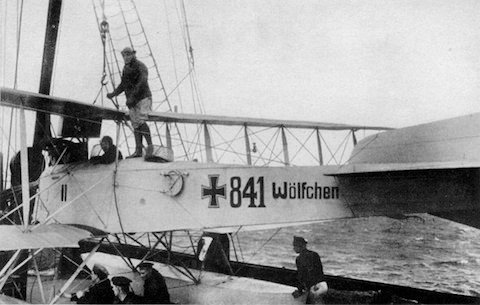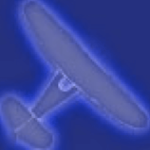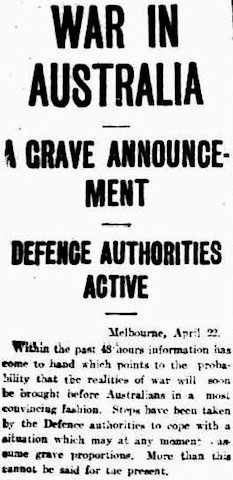Like Gaul and probably some other things, my mystery aeroplanes paper will be divided into three parts:
- An overview of the 1918 Australian mystery aeroplane scare itself.
- The immediate historical context which helps explain the scare, namely the threats from German raiders and of Allied defeat.
- The bigger picture into which the scare fits, namely other mystery aircraft waves before and since, in Australia and elsewhere.
That’s a fair bit to do in limited space (the paper is 20 minutes long with 10 minutes for questions; the formal version no more than 8000 words including references) so I need to have a thorough understanding of my material: what is essential and needs to be included and what is not-essential and should be left out.
So what material do I have? There are next to no secondary sources on the scare that I’m aware of, apart from passing references; conversely, the great majority of my primary sources relate to it. I first came across the scare in Australian and New Zealand newspapers from March–April 1918, and that is certainly a key aspect as I’ll be arguing that press reports of mystery aeroplanes themselves helped to propagate the wave of sightings. I’ll probably have another look through Trove to see if there’s anything I’ve missed or has been digitised since I last looked. Really, though, I’ve already got enough here to work with.
But the press reports are only the tip of the iceberg. I’ve looked through domestic military intelligence files on ‘Reports of suspicious aeroplanes, lights etc’ held by the National Archives of Australia and these include very many more mystery aeroplane reports than were ever reported in the press. (Including Smithy’s sighting.) A hand-written index, which looks like it was compiled by 3rd Military District (i.e. Victoria) late in the scare, in NAA: MP1049/1, 1918/66 lists 152 nationwide for the whole war.1 Of these, 135 took place in 1918 (the majority in March and April but with a substantial number in May and June and only gradually tailing off towards the Armistice) and of these, 91 were from Victoria. (Expect more statistics in future posts.) The files themselves consist of letters from concerned citizens reporting their sightings, reports on local police investigations of sightings and suspects, press clippings (usually passed on from the censor), naval and military intelligence analyses, and copies of official correspondence regarding air-sea searches for raiders. There’s also a separate file, NAA: MP367/1, 512/3/1319, which has reports just from 2nd Military District (i.e. NSW). I haven’t compared this with NAA: MP1049/1, 1918/66 yet but it looks like it has some sightings which didn’t make it to the master file. Not that it’s necessary to get every last detail down, of course. The big picture is more important.
That brings me to the contextual section of the talk/paper. In terms of primary sources, the newspapers and military intelligence files give excellent clues as to how the mystery aeroplanes were interpreted (i.e. as German aircraft operating from raiders off the coast or from inland locations). I would also like to have a look at any NAA files from the Council of Defence (roughly the equivalent of the Committee of Imperial Defence in Britain) to see if it discussed the mystery aircraft and raider threat. But at this point I need to also need to dig into the secondary literature, so I can understand the Australian political and social context. Especially since Australian history is not my thing! So for example I’m currently reading John McQuilton’s Rural Australia and the Great War: From Tarrawingee to Tangambalanga (Carlton South: Melbourne University Press, 2011), which I’m finding very useful (though unfortunately the region of Victoria it focuses on seems to have missed out on mystery aeroplanes!) Of course, there is plenty of work I can tap into on the military and naval situation, so that’s fine.
The third part is in some ways the trickiest. I want to tie this scare into mystery aircraft scares in other countries (as well as invasion and spy scares). But if I’m not expert in Australian history, still less am I expert in American, New Zealand, Canadian, South African, Russian, Romanian, Norwegian, Swedish… There is some excellent work on national airmindedness to draw upon, that’s no problem; but unfortunately good, academic secondary sources on the scares themselves are scarce (I hope this is just my ignorance speaking but I fear not). There are some for the 1909 and 1913 British phantom airship waves; a couple of articles on the 1897 mystery airship wave in America. The other scares I know of don’t rate even that much, apart from discussions in ufological and sceptical literature. I could cite some primary sources, particularly where English is the relevant language; but for this type of comparative work (and given the word limit) having access to reliable surveys would be much better. I’ll seek out secondary literature but fear I will have to resort to some primary sources here, at least to show that these scares happened. I may well end up focusing on the British parallels, as it’s what I know best and seems to be the best documented, and just gesture towards the other scares. I can’t do everything in this paper, after all!
![]() This work is licensed under a Creative Commons Attribution-NonCommercial-NoDerivatives 4.0 International License.
Permissions beyond the scope of this license may be available at http://airminded.org/copyright/.
This work is licensed under a Creative Commons Attribution-NonCommercial-NoDerivatives 4.0 International License.
Permissions beyond the scope of this license may be available at http://airminded.org/copyright/.
- The numbered entries actually go up to 153, but the one corresponding to 25 has only been pencilled in: it looks like it reads ‘Eyres [sic] Peninsula (Where next?)’ which is a nice indication of how perplexing the reports must have been to the official mind. [↩]




Pingback: Airminded · When, what, where?
Pingback: The hydroairplane-supersubmarine threat to New York